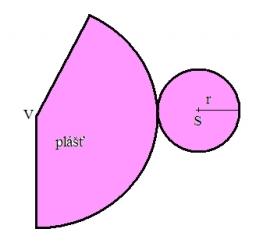Right-angled 25091
A thin plate in the shape of a right-angled triangle is turned once around the shorter hanger and a second time around the longer hanger. Cones are described by rotation. Are they the same volume? The dimensions are: shorter pendant 6cm, longer pendant 8cm.
Final Answer:

Tips for related online calculators
Tip: Our volume units converter will help you convert volume units.
See also our right triangle calculator.
See also our right triangle calculator.
You need to know the following knowledge to solve this word math problem:
arithmeticsolid geometryplanimetricsbasic operations and conceptsUnits of physical quantitiesGrade of the word problem
We encourage you to watch this tutorial video on this math problem: video1
Related math problems and questions:
- Calculate
 Calculate the cone's surface and volume from the rotation of the right triangle ABC with the squares 6 cm and 9 cm long around the shorter squeegee.
Calculate the cone's surface and volume from the rotation of the right triangle ABC with the squares 6 cm and 9 cm long around the shorter squeegee. - Right-angled trapezoid
 A right-angled trapezoid with the measure of the acute angle of 50° is given. The lengths of its bases are 4 and 6 units. The volume of the solid obtained by rotation of the given trapezoid about the longer base is:
A right-angled trapezoid with the measure of the acute angle of 50° is given. The lengths of its bases are 4 and 6 units. The volume of the solid obtained by rotation of the given trapezoid about the longer base is: - Rotation
 The right triangle with legs 11 cm and 18 cm rotates around the longer leg. Calculate the volume and surface area of the formed cone.
The right triangle with legs 11 cm and 18 cm rotates around the longer leg. Calculate the volume and surface area of the formed cone. - Rectangles - sides
 One side of the rectangle is 16 cm longer than a second. Shortening the longer side by 6 cm and extending the shorter by 9 cm increases the rectangle area by 250 cm². What are the dimensions of the original rectangle?
One side of the rectangle is 16 cm longer than a second. Shortening the longer side by 6 cm and extending the shorter by 9 cm increases the rectangle area by 250 cm². What are the dimensions of the original rectangle? - Perpendiculars 17003
 What is the hole volume drilled by the drill in the shape of a right triangle that revolves around a longer perpendicular? The perpendiculars of the triangle are 10 cm and 3 cm long.
What is the hole volume drilled by the drill in the shape of a right triangle that revolves around a longer perpendicular? The perpendiculars of the triangle are 10 cm and 3 cm long. - Right-angled triangle
 Determine the area of a right triangle whose side lengths form successive members of an arithmetic progression, and the radius of the circle described by the triangle is 5 cm.
Determine the area of a right triangle whose side lengths form successive members of an arithmetic progression, and the radius of the circle described by the triangle is 5 cm. - Two bodies
 The rectangle with dimensions 8 cm and 4 cm is rotated 360º first around the longer side to form the first body. Then, we similarly rotate the rectangle around the shorter side b to form a second body. Find the ratio of surfaces of the first and second bo
The rectangle with dimensions 8 cm and 4 cm is rotated 360º first around the longer side to form the first body. Then, we similarly rotate the rectangle around the shorter side b to form a second body. Find the ratio of surfaces of the first and second bo
